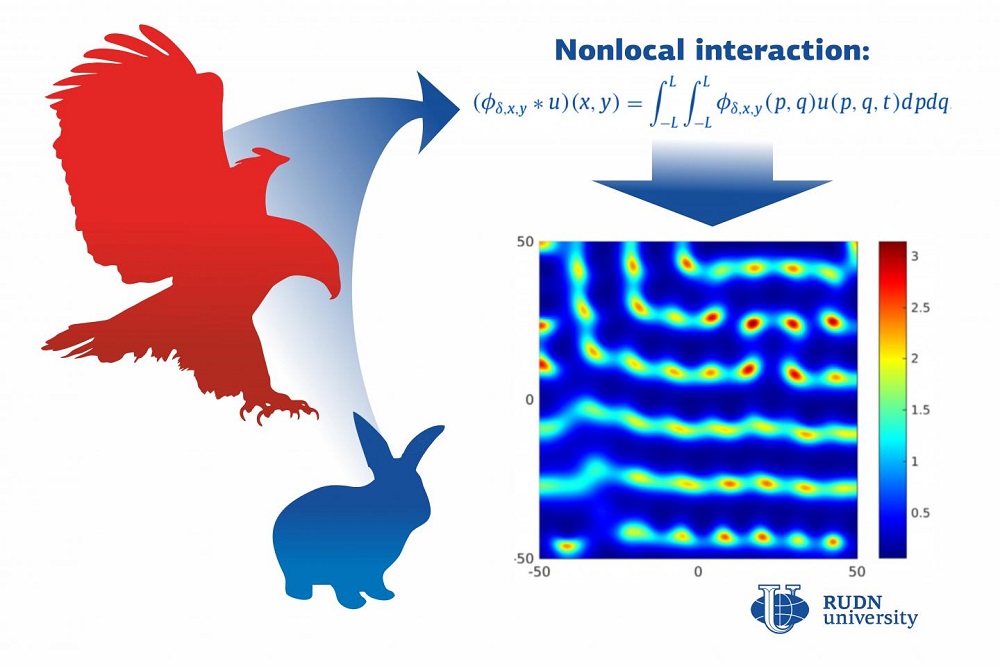Mathematician refines model of predator-prey relations in the wild

Ecologists use mathematical models of ecosystems to understand their structure and predict their development. Predator-prey is one of the basic models of this kind. With its help scientists can for instance calculate changes in the numbers of carnivores and herbivores depending on numerous conditions: the breeding of the latter, starvation of the former, amounts of prey eaten by predators, migrations, and so on. However, this model only takes into account local interactions, i.e. direct interactions between predators and prey in each given spatial location, while actual ecosystems also include nonlocal ones. A mathematician from RUDN University working together with his colleagues from the UK and India enhanced the standard predator-prey model taking these less obvious factors into account. Using his work, ecologists will be able to better understand developments in natural systems.
One example of natural nonlocal interactions is arid regions. To grow there, plants need to have a vast root system to collect moisture from large territories, not just from the vicinity of their location. Mathematically, this nonlocality is expressed as an integral that sums up the effect of the whole system at each given point. The competition for food among herbivores is also nonlocal, so a model has to take into account the integral amount of food in a system, not at each particular place.
“Nonlocal properties of movement are of interest for researchers; however, the nonlocal origin of this dynamics is often discarded. Still, there are a lot of natural systems with nonlocal interactions. One of the best examples may be the vegetation-water system, especially in semi-arid regions. There, nonlocality is a direct result of extensive root networks. We have confirmed that the nonlocality of intraspecific interactions can be the cause of different system dynamics in the predator-prey model,” said Prof. Sergey Petrovskii from RUDN University.
The team tested their concept using computer modeling and found out that even if a system initially has equal numbers of carnivores and herbivores, after some time their quantities start to grow differently at different points due to nonlocal interactions. As a result, the total quantity of the system becomes dominated either by predators or prey, and different spatial patterns are formed. Another feature of a nonlocal system is bistability, i.e. possible coexistence of two patterns. This is an important attribute of nonlocality. It is the initial conditions that determine which pattern eventually succeeds.
An article about his work was published in the Communications in Nonlinear Science and Numerical Simulation journal.
RUDN summarized the results of the scientific competition "Project Start: work of the science club ". Students of the Faculty of Physics, Mathematics and Natural Sciences have created a project for a managed queuing system using a neural network to redistribute resources between 5G segments. How to increase flexibility, make the network fast and inexpensive and reach more users — tell Gebrial Ibram Esam Zekri ("Fundamental Computer Science and Information Technology", Master's degree, II course) and Ksenia Leontieva ("Applied Mathematics and Computer Science", Master's degree, I course).
The National Demographic Report, 2023 Demographic Well-Being of Russian Regions (hereinafter - the National Demographic Report) was prepared by the scientific team of the Institute of Demographic Studies of the Federal Research Center of the Russian Academy of Sciences, the Vologda Scientific Center of the Russian Academy of Sciences, Peoples' Friendship University of Russia, the Center for Family and Demography of the Academy of Sciences of the Republic of Tatarstan, as well as with the participation of leading scientists from the Republic of Bashkortostan, Stavropol Krai, Volgograd, Ivanovo, Kaliningrad, Nizhny Novgorod, Sverdlovsk Oblasts and Khanty-Mansi Autonomous Okrug–Yugra.
RUDN summarized the results of the scientific competition "Project Start: work of the science club ". Students of the Faculty of Physics, Mathematics and Natural Sciences have created a project for a managed queuing system using a neural network to redistribute resources between 5G segments. How to increase flexibility, make the network fast and inexpensive and reach more users — tell Gebrial Ibram Esam Zekri ("Fundamental Computer Science and Information Technology", Master's degree, II course) and Ksenia Leontieva ("Applied Mathematics and Computer Science", Master's degree, I course).
What is your first association with the word “laboratory”? Flasks and beakers? Microscopes and centrifuges? Yes, many of us would answer the same way.
The National Demographic Report, 2023 Demographic Well-Being of Russian Regions (hereinafter - the National Demographic Report) was prepared by the scientific team of the Institute of Demographic Studies of the Federal Research Center of the Russian Academy of Sciences, the Vologda Scientific Center of the Russian Academy of Sciences, Peoples' Friendship University of Russia, the Center for Family and Demography of the Academy of Sciences of the Republic of Tatarstan, as well as with the participation of leading scientists from the Republic of Bashkortostan, Stavropol Krai, Volgograd, Ivanovo, Kaliningrad, Nizhny Novgorod, Sverdlovsk Oblasts and Khanty-Mansi Autonomous Okrug–Yugra.